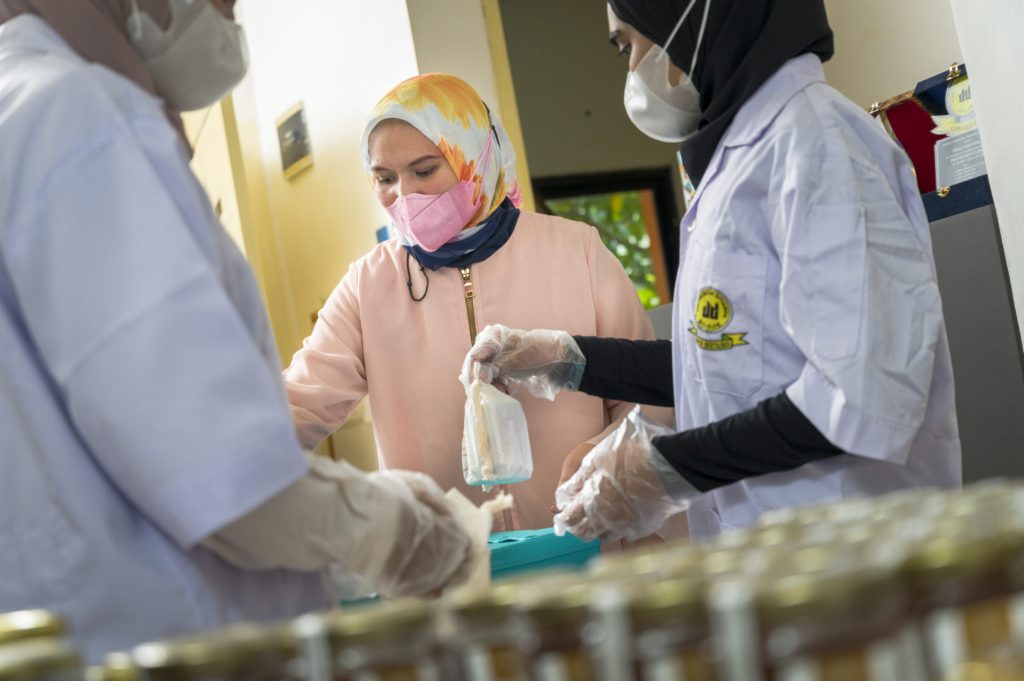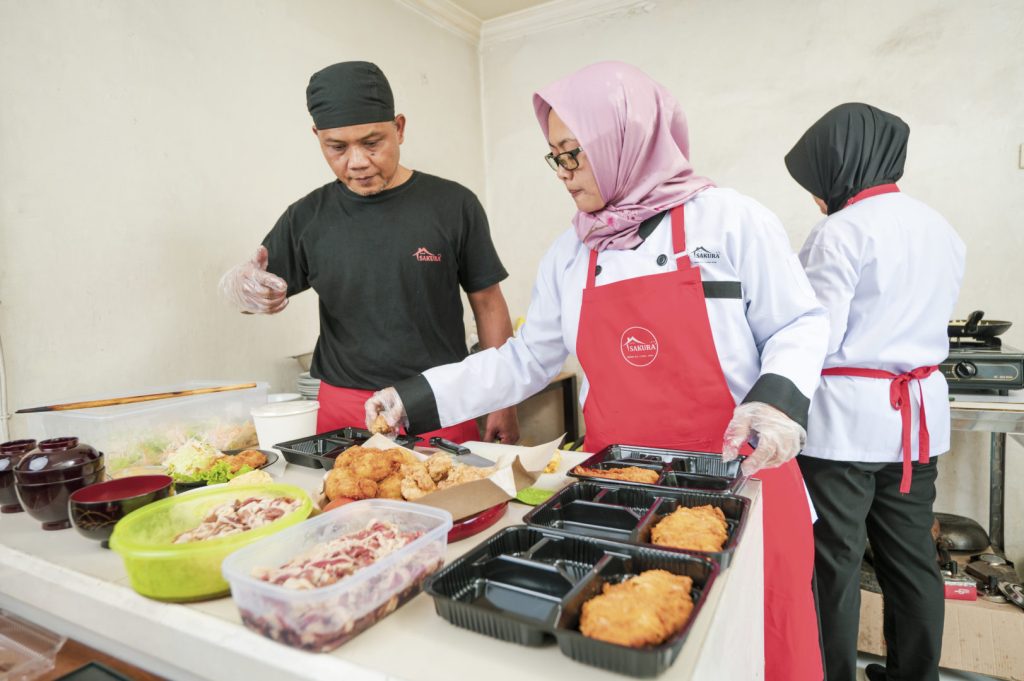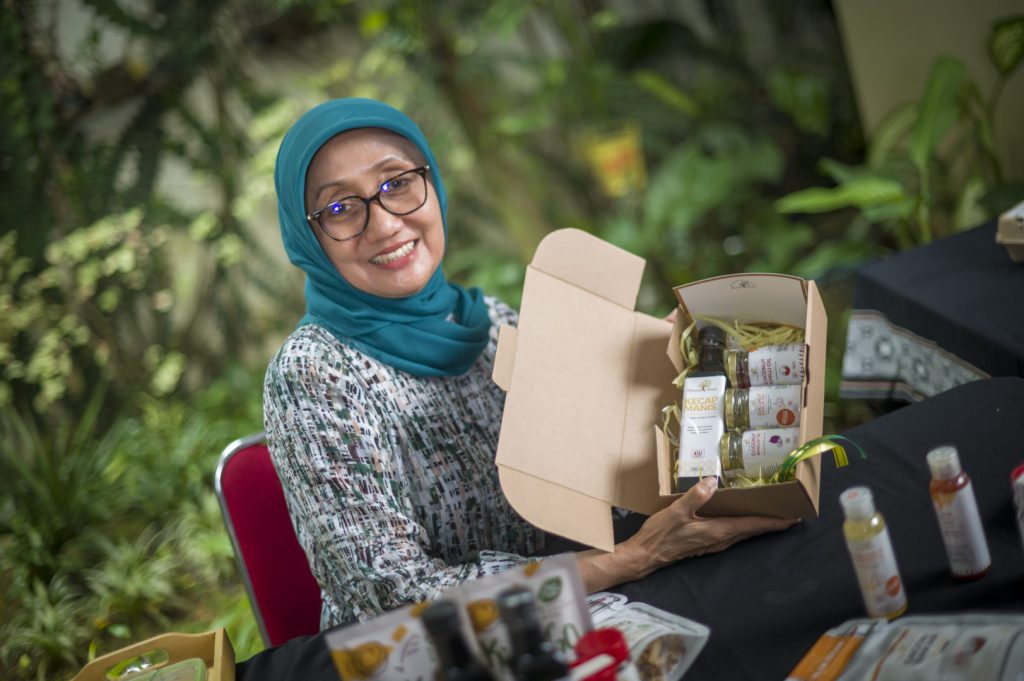Multi-stakeholder public-private partnerships: collaboration, innovation and growth
Nathan Associates, Inc. is part of Cadmus. Original publication date: September 7, 2022. The feature story has been originally posted on Cherie Blair Foundation for Women.
Our WEAVE project ran in Indonesia and Vietnam in 2020 and 2021. It successfully supported over 12,000 women entrepreneurs through our three online programmes – in the midst of the global pandemic. Caroline Rubin, Managing Associate at Nathan Associates, shares learnings from our women’s entrepreneurship initiative in Vietnam and Indonesia.
WEAVE was delivered collaboratively by the Foundation, USAID, Qualcomm® Wireless Reach™ initiative, and in-country partners Kinara and WISE, using technology and assets developed with ExxonMobil Foundation.
For more than a decade, the private sector has become increasingly involved in the development sector. Governments have recognized that, when working alone, impact is limited to only what can be achieved with government resources; however, greater outcomes can be reached by supplementing those resources with private sector support.
To meet the United Nations Sustainable Development Goals and maximize global impact, governments must harness the private sector’s expertise, innovation, reach, and financial support. Public-private partnerships have been catalyzed and informed by the U.S. Agency for International Development’s Private Sector Engagement Policy and reemphasized through the UK Government’s Strategy for International Development, among others. The ways in which private sector partners have engaged in development has evolved from solely co-funding activities of mutual priority to pursuing additional avenues of support, such as deploying innovative products and technologies, mobilizing private capital to invest in social enterprises, and interfacing directly with beneficiaries to provide knowledge and skills training on areas of expertise. The players have increasingly diversified as well to include NGOs, foundations, multi-national corporations, business networks and associations, and social enterprises, among other key stakeholders.
Public-private partnerships take many forms and often include more than one private sector and one public sector partner. But what is the secret for effectively leveraging the strengths of all partners to achieve maximum results? Take managing a team. A leader must define roles and responsibilities while playing to each team member’s strengths. The leader must foster a team that is flexible; when something doesn’t work, all team members must adapt. But how does this look for seven partners implementing a million-dollar grant?
The WEAVE project exemplifies that, with the right considerations, “the more, the merrier” can be true for public-private partnerships in development. This is especially true with the right convenor. NGOs such as the Foundation play a key role assembling the right mix of partners as well as providing expertise-led programmes.

The WEAVE Project
From May 2020 to November 2021, the Cherie Blair Foundation for Women responded to the emerging needs of women entrepreneurs in Vietnam and Indonesia with a new, wholly online pilot project, ‘Women Entrepreneurs Amplifying Ventures and Economies’ (WEAVE). The project promoted women’s economic empowerment through a three phased “learning journey” that brought together the Foundation’s three flagship programmes, tailored to women’s progression within their business’ development. This included:
- The Foundation’s mobile learning app, HerVenture, for 12,200 women at the early stages of their business.
- Six week online business management and investment readiness programme Road to Growth, for 266 women whose businesses had already been generating profit for two years and were seeking more investment.
- Mentoring Women in Business, the Foundation’s online professional mentoring scheme, delivered to 105 women with mature, existing businesses, carefully matching them with business professional mentors elsewhere in the region for six months.
How We Did It: The Partnership
The Cherie Blair Foundation for Women delivered WEAVE through two sources of funding. The first was funding from its long-term corporate partner, Qualcomm Wireless Reach. The second was a grant under the ASEAN-USAID Inclusive Growth in ASEAN through Innovation, Trade, and E-Commerce (ASEAN-USAID IGNITE) programme, implemented by Nathan Associates. The grant was provided to ASEAN-USAID IGNITE through USAID’s former Women’s Global Development and Prosperity (W-GDP) Fund, which aimed to source and scale the most impactful global women’s economic empowerment programmes.
In-country partners Kinara in Indonesia and Women’s Initiative for Start-ups and Entrepreneurship (WISE) in Vietnam – both non-governmental organizations – helped deliver the project on the ground from start to finish, including contributing to initial market assessments, participating in user testing of the HerVenture iOS app, marketing HerVenture, delivering Road-to-Growth training, and implementing the mentoring programme. This allowed WEAVE to leverage the organization’s unique expertise as local stakeholders with a proven track record of supporting women entrepreneurs in their national contexts, enabling sustainable, locally-led development.
WEAVE builds on and scales successful services created by the Foundation with Wireless Reach and the ExxonMobil Foundation. Wireless Reach, a collaborator of the Foundation since 2012, was a key partner in launching the HerVenture application and has provided year-on-year funding for HerVenture since the application was launched in 2018.

Keys to Success
The multi-stakeholder partnership implementing WEAVE was successful in part due to the following keys:
1. Effective communication and clearly defined, yet flexible roles for each partner. From the outset, the Foundation ensured clear roles and lines of communication for each partner. While each partner had clearly delineated roles and responsibilities, implementation challenges necessitated shifting and redefining the roles and scopes of each partner.
With the onset of the COVID-19 pandemic and the associated restrictions on international travel, the Foundation was unable to conduct face-to-face programming with beneficiaries. Instead of the Foundation being on the ground in-country, local partners Kinara and WISE stepped in to facilitate recruitment and registration of participants for programmes and quickly became familiar with the virtual training platforms, substantially increasing the number of women reached through WEAVE.
In addition, the Foundation experienced challenges communicating with mentees in the Mentoring Women in Business phase of WEAVE due to language barriers. However, local partners were able to communicate in local languages and through preferred communication styles (such as Whatsapp and Zalo). As a result, the Foundation created a formal role for local partners to support mentees throughout their mentoring journey and work with the Foundation to keep mentees and mentors engaged throughout the project. This clear delineation enabled the collaboration to effectively tap into the strength the local partners could provide to solve the communication issues with participating mentees.
2. Distinct and complementary strengths resulting in a mutually beneficial partnership. The Cherie Blair Foundation for Women and similar INGOs can offer globally tested and proven methods and programmes, as they often have a greater ability to pilot and test new approaches. They provide tried-and-true methods and programmes to donors like USAID that can fund and scale them, with the ease of knowing that funds are being well-spent on approaches that will achieve results. In scaling three Foundation programmes into WEAVE, the Foundation tapped into global reach of USAID and its ability to amplify, leveraging its brand recognition and reputation globally. From marketing WEAVE for recruitment to communicating results, USAID’s platform impactfully amplified the project, helping to propel it to success.
“We look for innovative, mutually beneficial partnerships to advance development progress. The WEAVE activity exemplifies this. The effective partnership structure enabled WEAVE to be contextualized, scalable, sustainable, and truly impactful.”
Steven G. Olive, Ph.D., Mission Director for USAID’s Regional Development Mission for Asia
The Foundation also played a valuable role in catalyzing investment by bringing multiple partners to the table and mobilizing two sources of capital. For both USAID and private sector partners, their investments went further, as they benefited from co-funding from each other. The USAID grant enabled the technology investment already made by private sector partners Wireless Reach and the ExxonMobil Foundation to go even further.
For both USAID and the private sector, these types of partnerships can help meet and demonstrate results in areas of political or corporate priority. In March 2021, President Biden signed an Executive Order, establishing the White House Gender Policy Council and recognizing that the “full participation of all people—including women and girls—across all aspects of our society is essential to the economic well-being, health, and security of our Nation and of the world.” Projects like WEAVE help underscore USAID’s commitment to uplifting women around the world. WEAVE also signals a commitment by private sector partners to promoting women’s empowerment by supporting women running small and growing businesses.

For USAID and the Foundation, WEAVE is a valuable tool to understand more about successful women’s entrepreneurship programming and to inform and improve the effectiveness for future activities. Regular lesson sharing, learning and reflection as well as quality data collection and monitoring enabled robust lessons learned for future women’s empowerment programming.
Finally, WEAVE benefited from the involvement of local partners Kinara and WISE that helped contextualize and tailor the project. Kinara and WISE gained an opportunity to continue to build their experience and expertise in women’s empowerment programming.
3. Robust focus on reflection and learning combined with flexibility from all partners to adapt programming accordingly. WEAVE conducted initial market assessments, held learning sessions with partners, and utilized a monitoring, evaluation, and learning (MEL) framework which was developed based on the Foundation’s organizational framework, as well as credible Women’s Economic Empowerment Frameworks published by Oxfam and the Donor Committee for Enterprise Development (DCED) to measure impact. The robust funding from partners allowed for in-depth market assessments to properly contextualize programming and a dedicated focus on data collection, monitoring, and evaluation that enabled real-time reflection and learning. This, coupled with flexibility from USAID to adapt programming based on lessons learned, enabled WEAVE to solve problems and implement a more impactful programme.
For instance, while WEAVE was adapted from previous programmes the Foundation ran in other countries, market assessments revealed that Indonesian and Vietnamese women entrepreneurs required soft skills training on topics such as leadership and influencing, in addition to the business skills training. All partners adapted to develop and implement a new leadership and influence-focused training module to supplement the Road to Growth phase of WEAVE. Forty percent of participants reported their knowledge of how they can use their leadership and communication style to influence others improved; 87% of the participants found the topic relevance of the training excellent; and 100% of participants indicated they would recommend this training to other women entrepreneurs.
With the right combination of partners that have clearly defined roles, effectively communicate, and bring complementary strengths, as well as the ability to work cohesively to adapt programming based on iterative learning, multi-stakeholder public-private partnerships can be a success.